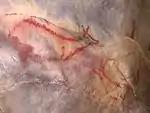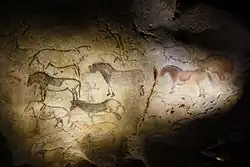Cave of Altamira and Paleolithic Cave Art of Northern Spain
The Cave of Altamira and Paleolithic Cave Art of Northern Spain (Cueva de Altamira y arte rupestre paleolítico del Norte de España) is a grouping of 18 caves of northern Spain, which together represent the apogee of Upper Paleolithic cave art in Europe between 35,000 and 11,000 years ago (Aurignacian, Gravettian, Solutrean, Magdalenian, Azilian). In 2008, they were collectively designated a World Heritage Site by UNESCO.
| UNESCO World Heritage Site | |
|---|---|
-Museo_Arqueol%C3%B3gico_Nacional.jpg.webp) Replica of the Cave of Altamira at the National Archaeological Museum (Madrid) | |
| Location | Northern Spain |
| Includes |
|
| Criteria | Cultural: (i), (iii) |
| Reference | 310bis |
| Inscription | 1985 (9th Session) |
| Extensions | 2008 |
| Buffer zone | 2,234.706 ha (5,522.08 acres) |
| Coordinates | 43°22′39″N 4°07′21″W |
.svg.png.webp) Location of Cave of Altamira and Paleolithic Cave Art of Northern Spain in Earth | |

Chief among these caves is Altamira, located within the town of Santillana del Mar in Cantabria. It remains one of the most important painting cycles of prehistory, originating in the Magdalenian and Solutrean periods of the Upper Paleolithic. This cave's artistic style represents the Franco-cantabrian school, characterized by the realism of its figural representation. Altamira Cave was declared a World Heritage Site in 1985. In 2008, the World Heritage Site was expanded to include 17 additional caves located in three autonomous communities of northern Spain: Asturias, Cantabria and the Basque Country.
List of caves
See also
References
- Cave of Altamira and Paleolithic Cave Art of Northern Spain (unesco.org)
- Pike, A. W. G.; Hoffmann, D. L.; Garcia-Diez, M.; Pettitt, P. B.; Alcolea, J.; De Balbin, R.; Gonzalez-Sainz, C.; de las Heras, C.; Lasheras, J. A.; Montes, R.; Zilhao, J. (14 June 2012). "U-Series Dating of Paleolithic Art in 11 Caves in Spain". Science. 336 (6087): 1409–1413. Bibcode:2012Sci...336.1409P. doi:10.1126/science.1219957. PMID 22700921. S2CID 7807664.



.jpg.webp)


.png.webp)


.png.webp)
.jpg.webp)





